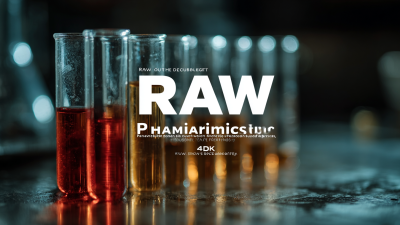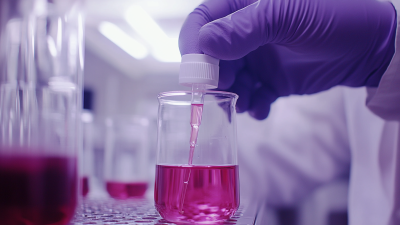
Exploring the Future of Raw Pharmaceutical Materials in Sustainable Healthcare
In recent years, the demand for sustainable healthcare solutions has prompted a significant shift towards the utilization of Raw Pharmaceutical materials. According to a report by Grand View Research, the global pharmaceutical excipients market, which includes these essential materials, is projected to reach USD 8.9 billion by 2027, growing at a compound annual growth rate (CAGR) of 6.8%. This trend is driven by the increasing focus on environmentally-friendly practices and the need for cost-effective production methods.

As healthcare professionals seek to improve patient outcomes while minimizing ecological footprints, the role of Raw Pharmaceutical materials becomes critical. The integration of digital technologies and innovative supply chain practices will further enhance the sustainability and efficiency of sourcing and producing these materials, thus shaping the future of the pharmaceutical industry. By exploring these developments, we can better understand the potential impacts on both healthcare and environment sustainability.
The Role of Digital Transformation in Sourcing Raw Pharmaceutical Materials
The role of digital transformation in sourcing raw pharmaceutical materials is becoming increasingly crucial as the healthcare sector pushes towards sustainability. With the integration of advanced technologies such as blockchain, artificial intelligence, and big data analytics, pharmaceutical companies can enhance the traceability and quality of raw materials. These technologies not only streamline the sourcing process but also ensure that materials meet stringent regulatory standards, thereby reducing the risk of contamination and fraud.
Moreover, digital platforms allow for better collaboration among stakeholders in the supply chain, fostering transparency and efficiency. By utilizing cloud-based solutions, companies can access real-time data, making informed decisions about sourcing based on market trends and environmental impact. This not only supports sustainable practices but also drives innovation in developing more eco-friendly materials. As healthcare continues to evolve, embracing digital transformation will be key to creating a resilient and sustainable supply chain for raw pharmaceutical materials.
Exploring Raw Pharmaceutical Materials Trends in Sustainable Healthcare
This chart represents the increasing trend in the sourcing of raw pharmaceutical materials, with a focus on sustainable practices and digital transformation integration.
Innovative Approaches to Sustainable Extraction and Processing of Pharmaceutical Ingredients
The future of raw pharmaceutical materials in sustainable healthcare is being shaped by innovative approaches that prioritize sustainable extraction and processing. With the growing demand for natural products across various applications, including food and beverages, dietary supplements, nutrition, personal care, and cosmetics, the market for functional extracts is witnessing remarkable growth. It is projected that the biotechnology ingredient market will grow from USD 2.32 billion in 2025 to USD 3.91 billion by 2032, reflecting a compound annual growth rate (CAGR) of 7.7% during this period.
As we explore the applications of these materials derived from fruits, flowers, and seeds, it’s essential to consider how sustainable practices in extraction can lead to preservation of biodiversity while catering to consumer demands. Integrating AI in traditional methodologies, particularly in Chinese medicine, is creating a new pathway for innovative product development and identification of high-value extraction processes.
**Tips:** When considering the use of bioactive compounds in formulations, prioritize suppliers who are committed to sustainable practices. Additionally, staying informed about technological advancements in extraction processes can provide a competitive edge in the market. Engaging in collaborations within the industry can also yield fresh insights and foster innovative solutions in product development.

Integrating Best Practices for Eco-Friendly Supply Chains in Healthcare
As the healthcare industry increasingly recognizes the importance of sustainability, the integration of eco-friendly practices in the supply chain for raw pharmaceutical materials is crucial. The global pharmaceutical market is projected to reach $1.57 trillion by 2024, according to a report by Grand View Research. This rapid growth highlights the necessity for industry players to adopt sustainable sourcing and manufacturing practices to minimize environmental impacts.
To facilitate these efforts, companies must prioritize best practices such as sourcing raw materials from certified sustainable suppliers and utilizing green chemistry principles in their manufacturing processes. This not only reduces waste but also lowers carbon emissions associated with production. According to the Pharmaceutical Supply Chain Initiative, implementing sustainable practices can lead to significant cost savings—up to 20% in some cases—through improved resource efficiency.
Tips: Start by assessing your current supply chain and identify areas where you can implement greener practices. Consider collaborating with suppliers who are committed to sustainability. Regularly educate your team on the importance of eco-friendly approaches to enhance overall awareness and engagement in sustainability efforts.
The Impact of Regulatory Frameworks on Sustainable Raw Material Usage
The sustainable use of raw pharmaceutical materials is increasingly influenced by regulatory frameworks that dictate environmental compliance and safety standards. These regulations not only aim to minimize environmental impacts but also encourage the adoption of green chemistry principles in pharmaceutical production. By establishing guidelines that promote renewable resources and waste reduction, regulatory bodies can drive the industry towards a more sustainable model, ultimately enhancing the overall lifecycle of pharmaceutical products.

Moreover, the interaction between regulatory frameworks and industry practices creates a ripple effect on innovation in sustainable raw materials. Companies are incentivized to invest in research and development for eco-friendly alternatives to conventional materials, transforming supply chains to enhance sustainability. However, the complexity and variability of global regulations can also pose challenges for pharmaceutical manufacturers. Adapting to diverse standards requires a thorough understanding of local and international policies, but it simultaneously offers opportunities to pioneer best practices in sustainable operations. Thus, a well-aligned regulatory landscape is crucial in shaping a future where raw materials are sourced responsibly and sustainably in the healthcare sector.
Future Trends in Biodegradable and Renewable Pharmaceutical Materials
The pharmaceutical industry is witnessing a significant shift towards biodegradable and renewable materials, driven by a growing demand for sustainable healthcare solutions. According to a report by Grand View Research, the global biodegradable polymers market is projected to reach $8.5 billion by 2027, expanding at a compound annual growth rate (CAGR) of 20.6%. This momentum indicates a robust interest in eco-friendly alternatives that not only reduce environmental impact but also enhance patient safety.
Innovative materials such as polylactic acid (PLA) and polyhydroxyalkanoates (PHA) are leading the charge, designed to break down naturally in the environment and minimize pollution.
In addition to biodegradable options, the pharmaceutical sector is increasingly exploring renewable natural sources for raw materials. The market for renewable pharmaceutical materials is expected to grow significantly, with a projected CAGR of 15% through the next five years, as highlighted in a recent report by Mordor Intelligence. This growth is fueled by advancements in biotechnologies and materials science, enabling the efficient production of drugs from plant-based sources. This shift not only promises a reduced carbon footprint but also aligns with the pharmaceutical industry's broader commitment to sustainable practices, ensuring that healthcare can meet present needs without compromising future generations.
Related Posts
-

Unlocking the Secrets of Best Raw Pharmaceutical Specifications and How to Choose the Right Supplier
-

Understanding the Essentials of Pharmaceutical Chemicals for Your Business Success
-

7 Outstanding Pharmaceutical Chemicals You Should Know for Global Sourcing
-

Evaluating the Best Pharmaceutical Chemicals: A Comprehensive Buyer’s Guide
-

How to Source High Quality Pharmaceutical Chemicals for Global Supply Chains
-

Mastering Pharma Material Procurement: A Comprehensive Guide for Global Buyers
